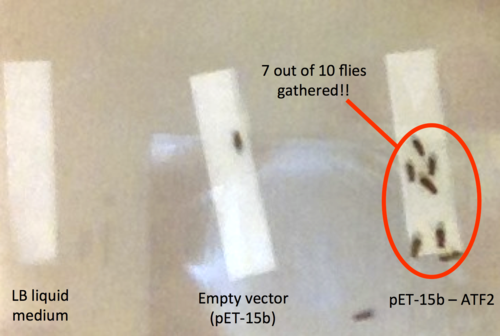Team:KIT-Kyoto/Project
From 2013.igem.org
Project Overview
We are trying to construct a novel E.coli that has fruity flavor like Japanese rice wine (Japanese sake). In order to accomplish the purpose, yeast genes related with production of the Japanese sake fragrance were introduced into E. coli cells. We also tried to develop a way to eliminate bad smells of E. coli in parallel. Although we previously won a gold prize by the development of a novel pen (E. coli Pen) in 2010, its bad smells were weak points and must be improved. We will overcome this problem through the progress of our new project in 2013. So far, “smell” is not a popular keyword and not a major field in iGEM. However, we believe that our project will provide a new point of view to iGEM friends.
Results
Applications of BBa_K1049001
We constructed ATF2 generator. (BBa_K1049002) Our team KIT-Kyoto 2013 constructed this part for the purpose of measurement. T7 promoter is an IPTG-inducible promoter. We added 20uL IPTG (100mM) to our genetically modified E.coli after cultivation at 28 and 37 degree C. 2 hours after, we extracted soluble proteins from it by using FastBreak™ Cell Lysis Reagent and did SDS-polyacrylamide gel electrophoresis.

Figure.1 SDS-PAGE Starting from the left, marker, ATF2 at 28 degree C, ATF2 + IPTG at 28 degree C, marker, ATF2 at 37 degree C, ATF2 + IPTG at 37 degree C
ATF2 gene encodes AATase, which is about 62kDa. The consumption of protein marker is like this.
Myosin 200kDa β‐Galactosidase 120kDa Bovine Serum Albumin 95kDa Glutamine dehydrogenase 68kDa Ovalbumin 50kDa Carbonic Anhydrase 36kDa Myoglobin 27kDa Lysozyme 20kDa Aprotinin 10kDa
You can find the band at lanes which are added IPTG just beneath the band of 68kDa.
Next, to confirm the activity of AATase, we added isoamyl alcohol after IPTG induction and cultivated for about 2 hours. We used E. coli cells carrying the empty vector (pET-15b) as a control and compare it with the E.coli cells carrying pET15b-ATF2 after addition of isoamyl alcohol. To compare the production of isoamyl acetate, we carried out a bioassay using Drosophila. Because Drosophila favors the fruit odor like isoamyl acetate. [1]
After the addition of IPTG and isoamyl acetate, the culture was impregnated into the filter and placed in a case containing 10 Drosophilas. We monitored the behavior of Drosophila. This is the result. For 1 hour, 7 flies gathered to the ATF2. These results clearly indicate that ATF2 produces isoamyl acetate from isoamyl alcohol.

In addition, according to this previous study [2], the ability of ATF2 protein producing isoamyl acetate in yeast is higher than ATF1 protein.
It is known that both ATF1 and ATF2 protein are involved in producing isoamyl acetate.

In 2006, MIT iGEM team submitted ATF1 coding sequence. (BBa_J45006) Our new part, ATF2 coding sequence, fall under the category of the improvement of function existing BioBrick Part, BBa_J45006. Herewith, our team, KIT-Kyoto 2013 iGEM team, meets the additional requirements for a Gold Medal.
[1] Yoshimoto Hiroyuki et al. "Mechanisms of Acetate Ester Production and Control in Yeasts -Monograph-", seibutsu-kogaku kaishi 79(2), 33-40, 2001-02-25
Future
About Future.
 "
"